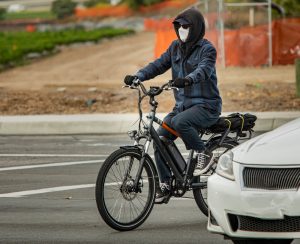How has the coronavirus pandemic helped the market for electric bikes?

The demand for e-bikes is growing up. The main reason for this growing demand is the positive response of people towards the E-bike due to various reasons. Additionally, Human transportation patterns may alter noticeably from those of the past due to COVID-19.
The E-bikes raise concerns about road safety as a result of their high speeds and less secure riding environment. These concerns are compared with the use of automobiles.
As a result, people are becoming increasingly interested in how COVID-19 may affect demand for travel, traffic congestion, and traffic safety. Evidence of the pandemic’s impact on urban transportation may be found anywhere in the world.
Though the E-bike manufacturers expected steady growth over the years, they had not expected such a blast. We discuss the findings of the research on the growth of the demand for e-bikes throughout the article.
-
Research Findings on the increase of demand for E-bikes

This incline has happened with the Covid-19 pandemic. A recent survey revealed that over 2,100 people in the UK were more interested in E-bikes before the pandemic. They have elaborated two main reasons less impact on the environment with carbon footprint and as a substitute for public transportation.
The age group of 25 to 34-year, have positively responded to the survey. They have mentioned that they are interested to purchase an E-bike and it was 17%. 40% of research participants believed that the reason people move to E-bike is the ability to act as an alternative to driving a car. To have a smaller environmental effect by minimizing their carbon footprint, 37% of respondents indicated, and 38% said it would be a substitute for public transportation.
-
Recorded a boost in sales in Europe during an outbreak

Though Covid-19 has adversely effect on most businesses. E-bike sale has resulted in rapid market acceleration. The E-bike market has recorded tremendous growth beyond all forecasts. As per the findings of VanMoof’s market survey, the demand for e-bikes has grown especially in London, Paris, and Berlin.
The growth has derived as a result of the increase of public awareness and also keen on advantages over environment and health.
The interest in commute E-bike has a strong interest as a product introduced to the specific niche. VanMoof, an E-bike distributor in Netherland has mentioned that their sale has tripled in 2020. It is noteworthy that out of half of the total sale of Bikes was E-bike. On the Cycling in Switzerland network, which is primarily intended for pleasure and recreation. Further, bicycle traffic in Switzerland climbed by 10% between 2019 and 2020.
Cycling decreased during the shutdown in Zurich and Basel and quickly returned after it.
The highest growth of riding an E-bike, 32% recorded in rural areas in Switzerland. However, only 4% of records are from urban areas. An expanded list of bicycle counters in metropolitan areas reveals that 72 of the 134 counters. It is 80% in general with increases of higher than 10%.
The media widely described the growth in bike sales, the scarcity of spare parts, and the increasing need for maintenance both during and after the epidemic.
-
E-bike sale is skyrocketing in the USA

Third of largest sales revenue under the cycling category generate by the E-bikes of cycling category in the USA. This implies that the revenue generated from Cycling has increased by 240% in 2021. The growth is 16 times higher than regular E-bikes. The USA companies expect this will double in the next five to ten years. Positive attitudes towards E-bike in the USA generate this sale. The research was conducted in New York and Las Vegas. The research further revealed that the people in those large cities tend to choose E-bike for short distances more than now before the pandemic. Further, sales of e-bikes have grown by 35% in New York and 32% in Los Angeles in 2020. 64% of the young generation in age between 25 to 34 years are more likely to purchase an E-bike for their commute travels.
-
How companies adapt to this change

The e-bike company WAU, Nottingham has recently opened a new factory in Essex. It will meet the demand in the South Woodham area once it is open in 2022.
The WAU had worked hard to meet the rise of demand and welcomed the rise with open arms. This critical social movement has caused historic shortages of electric bikes globally.
-
Changes in new habits generated by the E-bike

Public transportation took a blow during the epidemic. Thus, usage of subway trains alone fell by 90% in New York City. However, it was a common scene of riding E-motor bikes or e-bikes. Around cities. It turns out that the popularity of such bikes has blown up. Not only in the USA but in most urbanized cities around the world.
It took just three months to adopt a new habit, but the pandemic has given the additional time to become used to personal transportation options. As a result, companies responded instantly and acquire the market of green countries like Germany, France, and the Netherlands.
-
Developments in E-bike with the rapid growth

Prime idea was to reduce commute times while traveling quickly and comfortably. However, there are concerns over storage space, usefulness, and road safety. The enormous amount of e-bike sales encourages further development of design and easiness of the E-bike to address the above issues.
Even though bike-share systems are nothing new, the advent of e-bikes makes it possible for speeds as exceed 15 mph. E-bike speed has more often associated with experienced cyclists. This was feasible by an electric motor because the bike was forward while the user pedaled.
-
Changes in the Demographic factors

According to the founder and CEO of VOLT Bikes, the demand for e-bikes was outstanding in 2020. This growth has happened as a result of a combination of factors. These factors include environmental awareness and maintaining a healthy lifestyle during emergency lockdowns. Moreover, lower prices for e-bikes compared to other powered personal transportation options.
The owner of WEU Bike Company stated that the increase in demand for the E-bike range is decided by four factors. Those 4 factors are mentioned below
- Time-saving benefit
- Easy commute
- Ability to skip the growing traffic,
- Effortless riding.
Further, these factors took the attention of the people with the pandemic. The executive director of the North American Bikeshare Association, their organization promotes the usage of e-scooters, e-bikes, and bike-share systems. The ability of the individual of owning an E-bike decides in a certain physical, economic, and social setting. This has distinguished people from one another.
-
The velomobility system
Numerous scholars have emphasized the need of taking into account a wide variety of personal, social, political, and material factors while researching riding E-bikes. They have developed the idea of the “system of velomobility.”
Many e-bike users engage in unsafe activities such as speeding, using motorized surfaces, not using helmets, and ignoring traffic signals. This opposite of the velomobility system.
-
Government support to promote the E-bike

The E-bike was not fairly promoted by the governments before. However, attitudes toward E-bikes have changed. The E-bike has become the best alternative for car driving for a shorter distance.
Politicians are now suggesting e-bikes as a practical transportation option. The governments have also unveiled several incentive schemes. These schemes include the Active Travel Fund and subsidies. Further, green initiatives encourage public use of E-bike emphasizing the benefits for both lives and roadways.
Divvy e-bikes accounted for 10 percent of all bike share rides in August 2020. It is the month the E-bike riding. According to bike-share data, E-bike usage climbed to nearly a quarter of rides in September. The bikes make up a third of the city’s bike-share rides.
People who have felt nervous riding in a car might now remark. After seeing the Divvy bike at the height of the epidemic, we also provided steep discounts to provide individuals with a legitimate alternative. If they felt unprepared to use public transportation, according to Bilge.
Demand for E-bikes in Asia countries

According to statistics from E-bike Company BCycle- Lyft, e-bike travels accounted for more than 25% of bike-share trips. E-bikes made up more than 70% of bike-share rides in the Bay Area.
E-bikes helped certain cities focus on increases in bike-sharing usage. There were 531,000 bike-share trips in May in Chicago in 2021 compared to 338,000 in 2019, with a third of those extra rides being on e-bikes.
Data from automatic bicycle counters enables analysis of the evolution of traffic, usually highlighting the rapid recovery of cycling and growth to a higher level than before the pandemic. This was the case in Budapest where, after an initial period of decline at the beginning of the pandemic. The E- bicycle selling value is more than double compared to the previous year. It has identified an increase in cycling in European cities that implemented Covid cycle lanes, and ridership data also shows the same trend of bicycle sharing schemes. This happens for rebounding quickly after the first lockdowns
-
What has concerned the new E-bike users

Safety concerns have also been raised by the riders in terms of increasing speeds of E-bike. In a report published last year, the U.S. Consumer Product Safety Commission stated that e-bikes were responsible for 9% of micro-mobility accidents. The term “micro-mobility” describes transportation tools like e-bikes.
E-bikes accounted for 20% of the Citi Bike fleet in the New York City region in 2021. E-bikes make up 13% of the Capital Bike-share fleet in Washington, DC. But 23% of all rides. In Chicago, the ratios were more even, with e-bikes accounting for a third of all rides last month and a third of Divvy bikes being electric.
-
Increase the demand for E-bike sharing

According to the Executive Director of BCycle, an incredible increase in sales or ridership had experienced ever than before.
Nevertheless, according to Ramaker and BCycle, there was a huge increase in overall ridership in 2020 over the previous year.
Even after the epidemic ridership increased in 2020. Especially, e-bike demand has derived. 40 cities have BCycle bike-share systems, and 21 of them include electric bikes.
-
Factors affected of Bike sharing facilities

The utilization of the Metro Bike Share decreased in Los Angeles in 2020. This indicates that the trend did not continue there. In comparison to March 2019, ridership has reduced by approximately half. To reduce dockless bikes from its infrastructure and discourage public transportation. Metro stopped 58 bike stations last year because of stay-at-home orders and the state eliminated its social exclusion and capacity restrictions.
The same pattern of reduction was observed in Columbus. The total number of bike-share trips decreased by 37% in May of this year. It was the peak of 7,000 rides in 2020. Despite this, about 50% of the rides were on e-bikes.
-
Increase the demand for E-bikes in China

As of 2013, China was the world’s top manufacturer and exporter of electric bikes. Production of E-bikes exceeds 350 million annually. E-bikes are preferred over traditional bikes and public transportation in China. It is because of enabling commuters to cover larger distances even before the pandemic.
COVID-19 affects China’s e-bike safety based on a province-level dataset containing e-bike safety from 2017 to 2020. The survey confirms the high relevance between COVID-19 and the e-bike safety condition in China.
-
The reasons for the increasing demand for E-bikes

The application of lockdown procedures has become increasingly common. The main reasons for deriving the demand for E-bike sharing in China were especially traveling limitations and social distance rules. Its detrimental effect on productivity, adds to social expenses and shocks the world’s financial and social economies. Driving frequency and vehicle kilometers driven decreased by nearly 30% in China.
-
The future of E-bike beyond being new normal

In the future, physicians may advise patients to use electric bicycles, with the option to stretch out the expense or buy the bikes at a lower price.
Despite the challenging year, there could be a little bright spot in the epidemic. The epidemic has caused a change in our behavior about physical exercise and elevated awareness of traffic congestion and air pollution. As a result, fewer of us commute and generally less motorized transport. When compared to motorized vehicles, the e-bike is two-wheeled and ecologically friendly. The driving pattern of many countries dramatically changed. These countries may include Australia, Europe, the United States, and China.
There is growing interest in the possibilities of e-bikes for those individuals who are advised to engage in physical exercise. In the future, physicians may advise patients to use electric bicycles with the option to stretch out the expense or buy the bikes at a lower price.
Conclusion

Despite the challenging year, there could be a bright spot in the epidemic. The epidemic has caused a change in our behavior about physical exercise and elevated awareness of traffic congestion and air pollution. As a result, fewer of us commute and generally less motorized transport.
There are several causes for a rise in cycling. The first is because of work from home and remote schooling. The necessity for physical separation and the fear of infection contributed to a significant drop in the number of people using public transportation.
